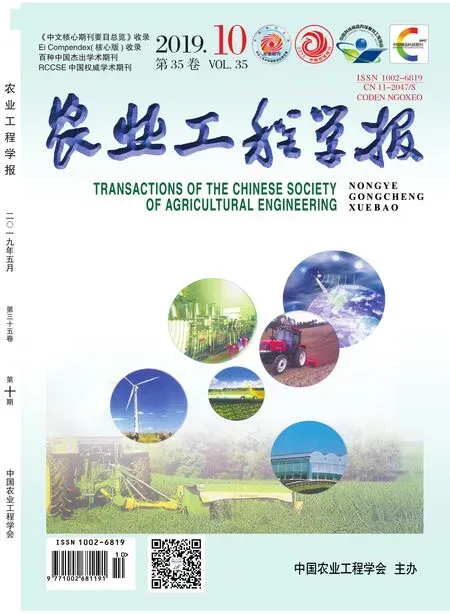Meta分析有机肥施用对中国北方农田土壤CO2排放的影响
王晓娇,张仁陟,齐 鹏,焦亚鹏,蔡立群,武 均,2,谢军红
Meta分析有机肥施用对中国北方农田土壤CO2排放的影响
王晓娇1,4,张仁陟1,2,3※,齐 鹏1,2,3,焦亚鹏1,蔡立群1,2,3,武 均1,2,谢军红2,5
(1. 甘肃农业大学资源与环境学院,兰州 730070;2. 甘肃农业大学甘肃省干旱生境作物学重点实验室,兰州 730070;3. 甘肃省节水农业工程技术研究中心,兰州 730070;4. 甘肃农业大学管理学院,兰州 730070;5. 甘肃农业大学农学院,兰州 730070)
为了探明中国北方地区不同气候类型、施肥措施、有机肥类型和试验年限下,有机肥施用(单施有机肥、有机无机肥配施)对生育期农田土壤CO2排放量的影响,该研究以不施肥、施用无机肥分别作为对照,根据已发表的相关田间试验数据,采用Meta分析方法,定量研究有机肥、有机肥配施无机肥对农田土壤CO2排放量的影响。结果表明:与不施肥、施用无机肥相比,有机肥施用总体上显著提高了农田土壤CO2排放量,分别提高了50.6%和36.3%;有机肥施用下,农田土壤CO2排放量依次减少的顺序为:单施有机肥、有机无机配施、无机肥+有机肥+缓释肥;采用有机肥+无机肥+缓释肥配施,土壤CO2排放量未显著增加;相比牛粪、猪粪和商品有机肥,鸡粪类有机肥对土壤CO2排放正效应最大;有机肥施用下,灰漠土农田土壤CO2排放量相对高;农田土壤CO2排放量与年均气温正相关,与年均降水量负相关。从环境的角度考虑,建议在中国北方采用无机肥+有机肥+缓释肥配施技术,不建议鸡粪大量施用及在灰漠土农田大量施用有机肥。该研究成果可为有机肥替代部分化肥在中国北方地区的推广应用提供参考。
呼吸;土壤;肥料;北方;Meta
0 引 言
中国实施的“生态文明”、“乡村振兴”、“化肥减量、有机肥替代”、“温室气体减排”等战略均反映出在农业领域有机肥替代化肥和温室气体减排的重要性。大量研究[1-5]表明,有机肥替代化肥施用,可改善土壤结构、增加土壤肥力、提高作物产量、提升品质、影响土壤呼吸,不同的气候类型、土壤类型和施肥措施下土壤呼吸对有机肥的响应也不同[6-8]。土壤呼吸是土壤释放CO2的过程,土壤呼吸强度可用土壤CO2排放量作为评价指标。因此,从环境角度考虑,明确不同区域农田施用有机肥对土壤CO2排放量的影响对农田温室气体减排具有重要意义。
近年来,在中国北方的典型区域均设置了有机肥施用的农业田间试验,也开展了一系列研究。较多研究[8-13]表明有机肥施用比不施肥、无机肥施用均提高了土壤呼吸通量,增加了农田土壤CO2排放量,部分研究[14]表明农田土壤CO2排放量在习惯施肥、优化施肥和有机肥配合优化施肥等处理间差异不显著。大多模拟、短期田间试验研究也表明有机肥施用下土壤呼吸通量变化受温度、水分、施肥措施和有机肥类型等因素影响[15-20]。由于不同研究的气候、管理措施和土壤属性等不同,施用有机肥后土壤CO2排放量对有机肥的响应可能存在很大的差异,哪些影响因素导致了差异[21-25],解决这些问题需要综合分析有机肥施用对农田土壤CO2排放量的影响[26-31]。
Meta分析是一种对同类研究结果进行统计分析的方法[32-34]。本研究运用Meta分析方法,以不施肥和无机肥施用分别作为有机肥施用的对照,通过收集现有的相关田间试验数据,量化不同条件下施用有机肥之后农田土壤CO2排放量的差异特征,明确农田土壤CO2排放量差异的主要驱动因子,以期为有机肥替代部分化肥在中国北方农业区的推广应用提供参考依据。
1 材料与方法
1.1 数据来源
通过Web of Science、Springer、中国知网(CNKI)、万方、维普、Google Scholar 等中英文数据库分别输入“有机肥(manure/organic fertilizer)”或(or)(牛粪:cow manure,猪粪:pig manure,鸡粪:chicken manure,羊粪:sheep manure)和(and)“温室气体(GHG/CO2/soil respiration/carbon dioxide)”和(and)“中国北方(north and china)”等关键词,检索了截止2018年5月1日前公开发表的中国北方有机肥施用与土壤呼吸相关的文献,并对检索到的文献进行筛选。筛选标准如下:1)试验区域为中国北方地区,试验起止年份清楚;2)试验方式为大田试验,试验时间跨度至少为1个生长季节(从种植到收获),且作物全生育期描述清楚;3)试验处理包含有机肥(单施有机肥、有机无机配施、无机有机缓释肥配施)、无机肥(单施氮肥、氮磷肥、氮磷钾配施)、不施肥(CK)等的1个或多个,且同一研究有机肥与不施肥或有机肥与无机肥对照明确;4)研究点的背景条件、研究方法明确。
通过EndNote剔除试验地点、试验年份、作物类型和试验数据结果相同的文献。对符合标准的文献提取区域(region)、试验点位置(experimental location,EL)、年均气温(annual average temperature,AAT)、年降水量(annual precipitation,AP)、土壤类型(soil types,ST)、施肥措施(fertilization measures,FM)、施肥年限(application time,AT)、施肥方式(application ways,AW)、有机肥类型(organic fertilizer types,OT)和标准差(standard deviation,S)等数据。本文收集的数据主要源于以下参考文献(表1)。
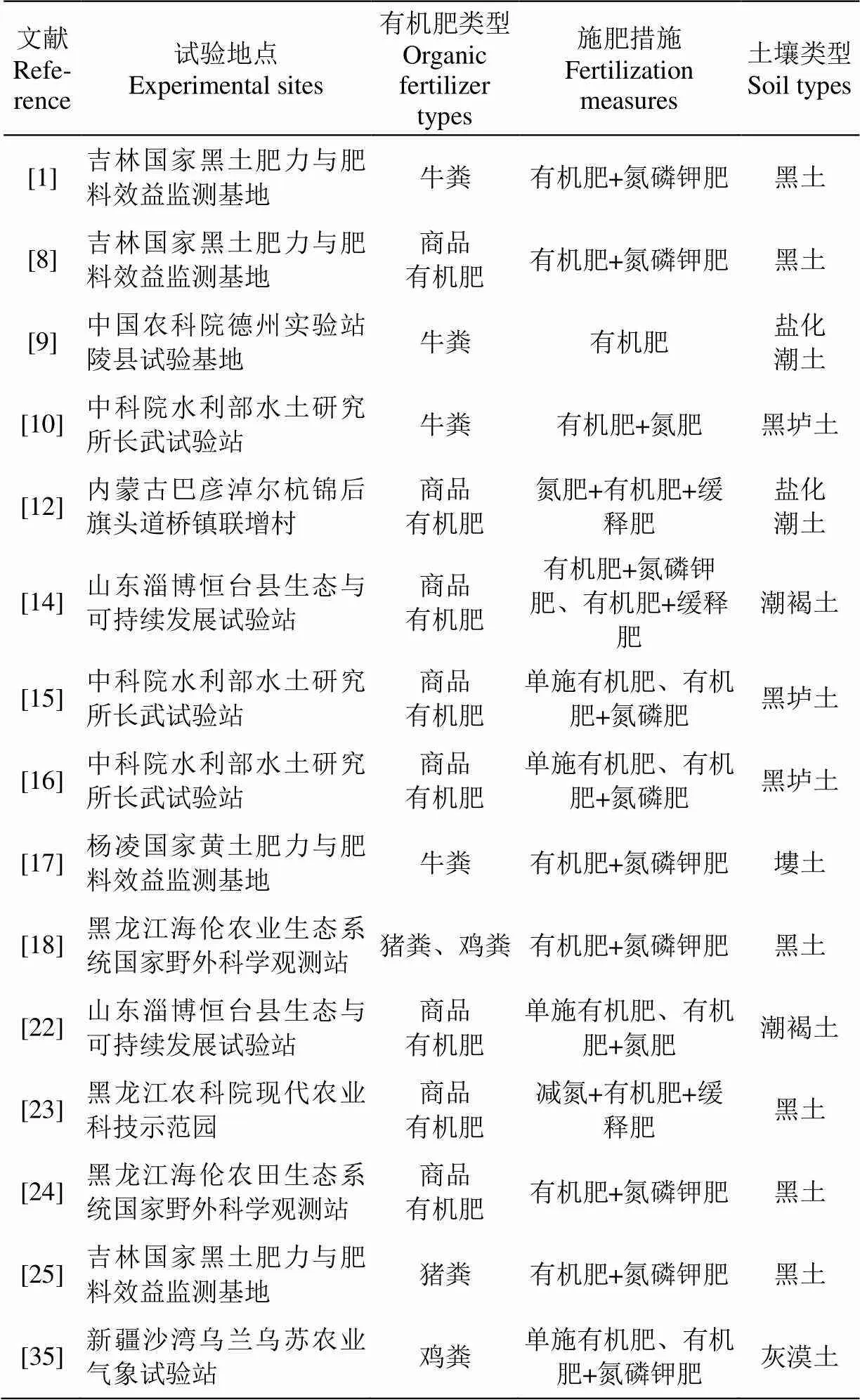
表1 Meta分析所用的参考文献
1.2 数据分类
根据文献中有机肥的施用方法,对筛选的数据进行分类,将试验组分为单施有机肥、有机肥+无机肥2类,对照组分为不施肥和施用无机肥,共收集了89组配对试验数据,其中,对照组为不施肥、施用无机肥的有效数据分别为42和47组。
考虑到本研究试验点数量的限制及分布在中国北方,本文根据种植制度[32,36-37]划分为3个区域:东北、华北和西北地区(表2);土壤类型分为黑土、灰漠土、塿土、潮褐土、黑垆土和盐化潮土;施肥年限分为4类(第1类:5 a以下;第2类:>5~10 a;第3类:>10~20 a;第4类:>20 a);施肥措施分为单施有机肥、氮肥+有机肥+缓释肥、氮磷钾+有机肥、氮磷+有机肥配施和无机肥;施肥方式分为基肥+追肥和一次性施肥;有机肥类型分为鸡粪和牛粪、猪粪和商品有机肥。

表2 中国北方农田区域划分及气候特征
1.3 数据分析方法
本研究的数据均来自检索的文献,在进行文献数据搜集时,以图表示的数据,用WebPlotDigitizer[38]软件提取。试验结果以排放速率表示的样本,计算出作物生育期内土壤CO2排放量,以CO2-C表示的样本,乘以44/12得出CO2的排放量。若文献中提供的数据为标准误(S),则利用重复次数()来计算标准差(),见式(1)。

利用各研究中处理组和对照组的平均值、标准差和重复数计算反应比(response ratio,RR)及研究的总体异质性,计算95%的置信区间(confidence interval,CI)[39]。
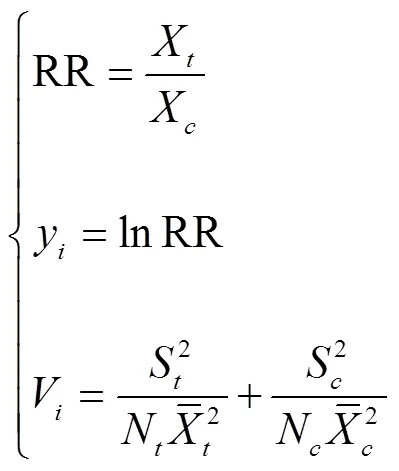

采用随机效应模型的限制性最大似然法计算平均效应值(effect size,ES)[40-41]。

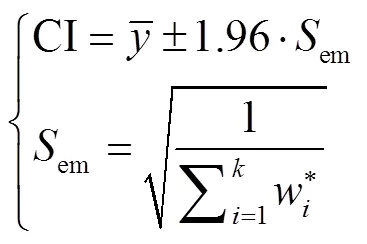
式中CI为累计效应值的95%置信区间;em为综合效应值的标准误。
为更直观地反映施用有机肥对土壤CO2排放效应,将效应量转化为增加率[42]

为筛选异质性影响因素,参考文献[40],通过建立1个或多个解释变量与结果变量之间的回归模型,用软件R内函数“glmulti”确定修正的小样本赤池信息量(Akaike’s information criterion corrected for small samples,AICc),查看AICc值最低的模型结果,确定最优模型,计算最优模型中各个影响因素的权重,所有最优模型子集中每个因素的权重加权之和被确定为每个因素的相对重要性,寻求最优模型中因素的重要性程度,以因素相对重要性>0.8表示重要[40,42],筛选导致异质性的重要影响因素。
所有数据分析均采用R3.4.4编程软件进行数据处理[43],使用R作图。发表偏倚检验用失安全系数法[40]。
2 结果与分析
2.1 施用有机肥对农田土壤CO2排放量的影响
总体上看,相比不施肥和无机肥,有机肥施用能显著提高农田土壤CO2排放量(<0.05),分别平均提高了50.6%(95% CI为37.7%~66.5%)和36.3%(95% CI为20.9%~53.7%)。有机肥与不施肥、有机肥与无机肥异质性检验结果分别为1 342.9、1 531.7(<0.05),表明异质性强,需要引入解释变量。通过失安全系数法检验发表偏爱性,有机肥与不施肥、有机肥与无机肥的潜在效应值分别为30 218和23 650(临界值为215和480),潜在效应值大于临界值表明无发表偏爱。
北方不同区域有机肥施用对农田土壤CO2排放量的影响(图1)表明,东北、西北和华北3个区域间农田土壤CO2排放量均无显著差异。几种不同类型有机肥施用对农田土壤CO2排放量的影响(图1)表明,与不施肥相比,牛粪、鸡粪、猪粪和商品有机肥施用下农田土壤CO2排放量均有显著的增加,分别增加了95.4%、498.9%、29.7%、30.9%(<0.05),鸡粪和牛粪、猪粪、商品有机肥差异显著,其他有机肥类型间差异不显著;与无机肥施用相比,农田土壤CO2排放量的规律同上,均反映出施用鸡粪后农田土壤CO2排放量高于其他类型有机肥。

图1 不同分类下土壤CO2排放量总体效应值
2.2 有机肥施用下农田土壤CO2排放量影响因素分析
2.2.1 影响因素的重要性分析
将数据按年均气温、年降水量、土壤类型、施肥年限、施肥措施和施肥时期分组,运用Meta回归分析进行多因素分析,寻求最优模型中影响因素重要性(图2)。相对重要性>0.8的影响因素包括年降水量、年均气温、施肥措施和土壤类型。
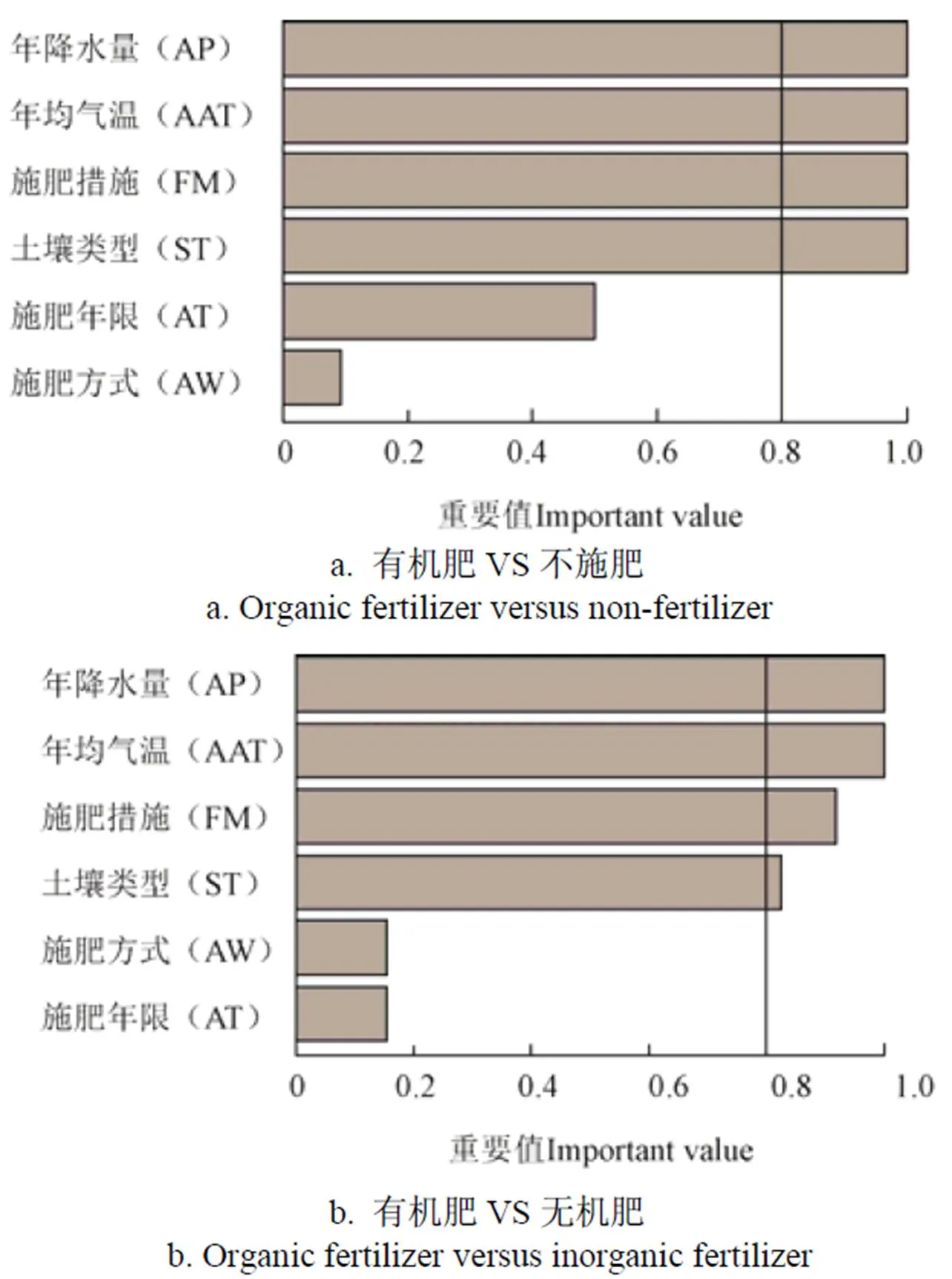
Note: AP: annual precipitation; AAT: annual average temperature; FM: fertilization measures; ST: soil types; AW: application ways; AT: application time.
2.2.2 农田土壤CO2排放量影响因素分析
1)不同气候条件
年均气温与效应值的关系(图3)表明,与不施肥相比(图3a),施用有机肥农田土壤CO2排放量随着年均气温升高显著增加(<0.05),年均气温能解释11%的效应值变异。与施无机肥相比(图3b),施用有机肥农田土壤CO2排放量随着年均气温升高显著增加(<0.05),年均气温能解释16%的效应值变异。总体上看,农田土壤CO2排放量随着年均气温升高而增加。
年降水量与效应值的关系表明,与不施肥相比(图3c),施用有机肥农田土壤CO2排放量随年降水量增加显著降低(<0.05),年降水量能解释10%的效应值变异,与施用无机肥相比(图3d),施用有机肥农田土壤CO2排放量随着年降水量增加显著降低(<0.05),年降水量能解释12%的效应值变异。总体上看,农田土壤CO2排放量随着年降水量增加而降低。
2)不同土壤类型
不同土壤类型下有机肥施用对农田土壤CO2排放量的影响(图4)表明,有机肥与不施肥相比(图4a),黑土、灰漠土、塿土、潮褐土、黑垆土和盐化潮土农田土壤CO2排放量均有显著的增加,分别增加了39.0%、301.4%、109.5%、23.4%、58.4%、113.8%(<0.05);灰漠土与其他土壤类型差异显著(<0.05),塿土与潮褐土差异显著(<0.05),其他土壤类型间差异不显著。与施用无机肥相比(图 4b),黑土、灰漠土、塿土、潮褐土、黑垆土和盐化潮土农田土壤CO2排放量均有显著增加,分别增加了16.1%、259.7%、20.9%、27.1%、32.3%、85.9%(<0.05),灰漠土与其他土壤类型差异显著(<0.05),其他土壤类型间差异不显著。

注:虚线表示95%的置信区间的上下限值,实线表示回归线,下同。
Note: Dotted lines are upper and lower limits of 95% confidence interval and solid lines are regression lines. The same below.
图3 影响因素与土壤CO2排放量的效应值的关系
Fig.3 Relationship between effect size and influencing factors on soil CO2emission
3)不同施肥措施
有机肥和无机肥配施对农田土壤CO2排放量的影响(图4)表明,与不施肥相比(图4c),单施有机肥、氮肥+有机肥、氮磷钾+有机肥、氮磷+有机肥配施下,农田土壤CO2排放量均有显著的增加,分别增加了78.6%、15.0%、56.8%、55.3%(<0.05),氮肥+有机肥+缓释肥、减量施氮+有机肥+缓释肥模式下农田土壤CO2排放量未显著增加,进一步两两比较,有机肥与氮肥+有机肥、氮肥+有机肥+缓释肥、减量施氮+有机肥+缓释肥间差异显著;与无机肥施用相比(图4d),有机肥、氮肥+有机肥、氮磷钾+有机肥、氮磷+有机肥配施下,农田土壤CO2排放量均有显著的增加,分别增加了66.5%、28.4%、29.6%、28.4%(<0.05),氮肥+有机肥+缓释肥措施下农田土壤CO2排放量未显著增加(>0.05),进一步两两比较,有机肥与氮肥+有机肥、氮磷钾+有机肥、氮磷 +有机肥差异显著。
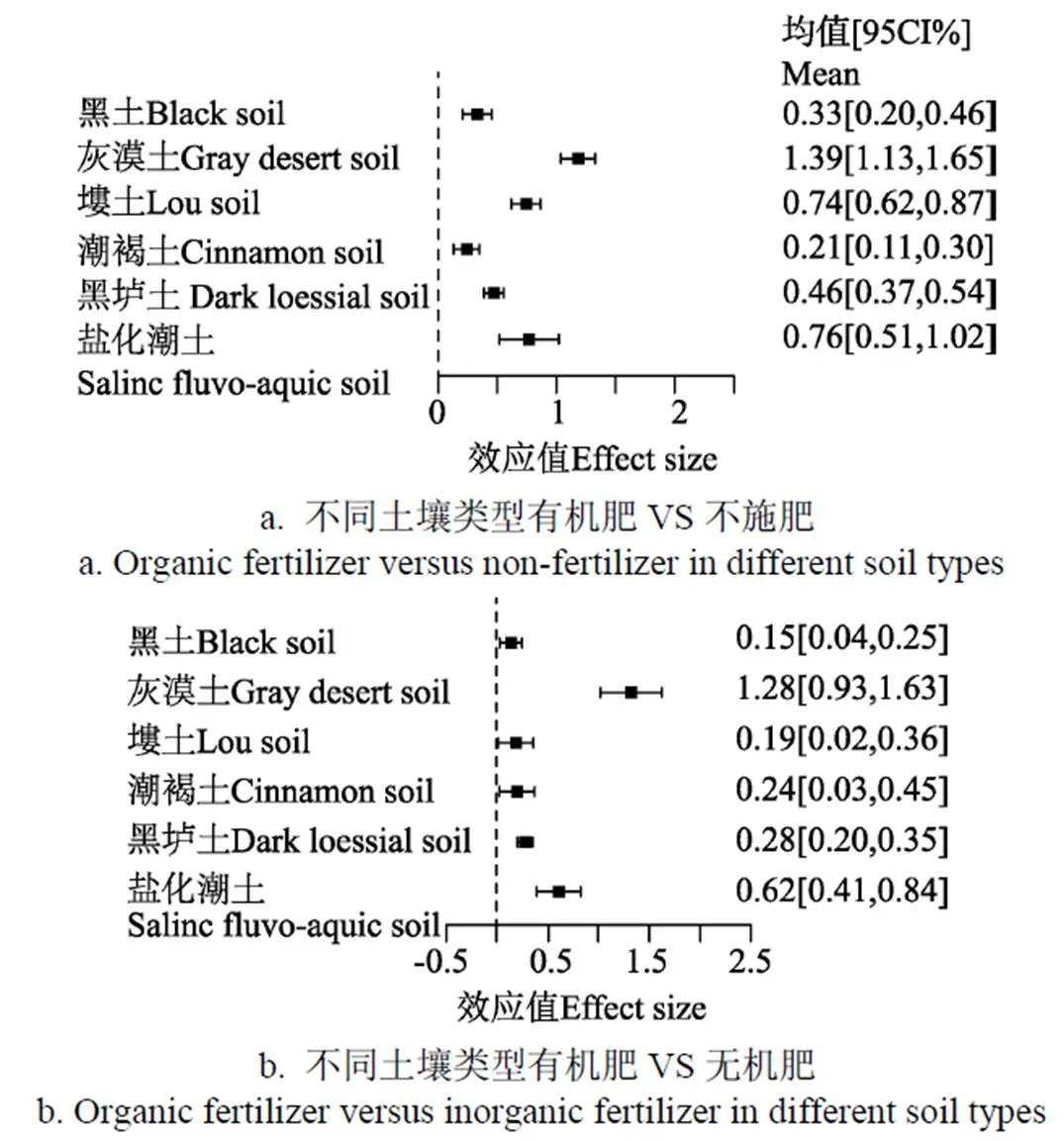
注:O:有机肥;N+O:氮肥+有机肥;N+O+SR:氮肥+有机肥+缓释肥;NPK+O:氮磷钾+有机肥;NP+O:氮磷+有机肥:RN+O+SR:减量施氮+有机肥+缓释肥
Note: O: organic fertilizer; N+O: nitrogen fertilizer + organic fertilizer; N+O+SR: nitrogen fertilizer + organic fertilizer + slow-release fertilizer; NPK+O: nitrogen, phosphorus and potassium + organic fertilizer; NP+O: nitrogen and phosphorus + organic fertilizer; RN+O+SR: reduced nitrogen + organic fertilizer + slow-release fertilizer.
图4 土壤CO2排放量的影响因素分析
Fig.4 Analysis of influencing factors on soil CO2emission
3 讨 论
本研究通过整理已发表的文献数据,运用Meta分析方法,从区域尺度分析了我国北方典型农田土壤施用有机肥后土壤CO2排放量特征及驱动因子。研究发现:与不施肥、无机肥施用相比,有机肥施用显著增加了农田土壤CO2排放量,分别提高了50.6%和36.3%(<0.05)。相关研究[8,9,21-23,25]也得出相似结论。本研究通过亚组分析也发现在不同区域、不同有机肥类型和不同土壤类型下有机肥施用均促进农田土壤CO2排放量,不同施肥措施间存在差异,农田土壤CO2排放量与平均气温呈正相关,与降水量呈负相关。分析原因:1)北方相对干旱少雨,有机肥施用显著增加了土壤碳库,土壤有机碳在环境因子的作用下矿化速率增大,成为土壤CO2排放的主要来源[44-45];2)有机肥比无机肥进一步改善了土壤孔隙度、有机质和养分等土壤理化性质,促进植物生长,根系分泌物增加,为微生物提供了可以利用的底物,使土壤呼吸增加[46-47];3)施用有机肥改善了土壤有效持水量、通气性,增加了蚯蚓、弹尾目密度和土壤动物多样性指数,促进了土壤动物呼吸的增加[48]。研究还发现,施用鸡粪后土壤CO2排放显著高于牛粪、猪粪和商品有机肥,相关研究[7,35]也得出相似结论。究其原因,鸡粪的养分含量高于牛粪、猪粪和商品有机肥,属热性肥料,有机氮含量高,C/N比较低,一般来讲土壤C/N与有机质分解速度呈反比关系,因为土壤微生物在生命活动过程中,既需要碳素做能量,也需要氮素来构建自己的身体,微生物的活性变化有可能促进了土壤CO2排放量[49-52]。
3.1 有机肥施用下农田土壤CO2排放量的影响因素分析
3.1.1 气候类型
本研究表明,有机肥施用后农田土壤CO2排放量随年均气温的升高而增加,随年降水量的增加而降低,较多研究得出相同的结论[53-55],分析其原因:1)温度是决定陆地生态系统碳循环过程的关键因素,温度影响着土壤呼吸过程的所有环节,在一定范围内增加温度可以提高土壤微生物活性,进而影响有机碳的矿化,从而使CO2排放量与气温具有极显著正相关关系[53,55];2)降水量影响土壤含水率,土壤CO2排放量与土壤水分含量呈极显著负相关[54],随着降水的增大,土壤含水率增加,可直接降低CO2在土壤孔隙中的扩散速率以及增加CO2在土壤水中的溶解量,导致呼吸速率下降。本研究与Birch效应[54]有一定差别,因本研究主要关注的是年降水量与生育期土壤CO2累计排放量的关系,Birch效应指干旱条件下单次少量降水激发了土壤呼吸的效应,研究侧重点不同。本研究发现,在效应值与年均气温、年降水量回归中,回归方程显著,但决定系数不高,对于一元回归模型,样本决定系数是研究自变量对因变量的解释程度。本研究样本量比较大,线性回归显著,但数据集中性可能不高,导致误差项方差大,使决定系数不高[39]。回归方程也说明了年均气温、年降水量影响农田土壤CO2排放量,但不是主要驱动因子。
3.1.2 土壤类型和施肥措施
研究发现有机肥施用下不同土壤类型均能显著提高农田土壤CO2排放量,其中灰漠土与其他土壤类型差异显著。灰漠土是在温带荒漠气候条件下形成的,主要分布在新疆、宁夏和甘肃等地区,土壤质地为粉砂壤或砂壤,腐殖质的积累作用弱,有机质含量低,有机肥施入后,灰漠土对有机物质的固持能力较弱,且灰漠土分布区气温相对高,矿化加剧,从而有机肥施用会提高灰漠土土壤CO2排放量[56]。研究也表明,单施有机肥比有机无机配施促进了农田土壤CO2排放,缓释肥+有机肥+无机肥配施模式下农田土壤CO2排放量均与不施肥、无机肥之间差异不显著,这与郭俊娒等有关研究[9,23]相似,原因主要是不同类型的肥料组合会降低有机肥的施用量,增加肥料利用效率,也可能是长期氮肥施用可以减弱土壤呼吸作用,促进碳在土壤中的贮存,具体机理可能是氨基形态的氮作用于可降解的木质素形成更稳定、难降解的芳香类化合物,也有可能直接抑制木质素分解酶的形成[57]。
本研究得出有机肥施用会增加农田土壤CO2排放量的结论。农田土壤CO2排放包括3个生物学过程和1个非生物学过程,因此,下一步研究需明确有机肥施用后的主导过程及形成机制[7];土壤CO2排放量增加能促进农田生态系统光合产物积累,增加土壤碳储量,形成固碳效应(A),另一方面也加剧了温室效应(B),已有研究也表明有机肥有改善土壤结构,增加作物产量、优化作物品质的效果[3-5],因此,要明确施用有机肥在低碳农业中的综合效应需界定在农田生态系统尺度,弄清A和B的关系,从基于生命周期评价碳排放的综合净温室气体、兼顾作物产量的温室气体排放强度和作物品质等3个方面综合分析[58-59]。
4 结 论
经对中国北方地区施用有机肥后作物生育期CO2排放量的综合分析,得出以下结论:
1)与不施肥和施无机肥相比,施用有机肥能显著提高生育期农田土壤CO2排放量;东北、华北和西北不同区域间差异不显著;不同有机肥类型中,施用鸡粪有促进土壤CO2排放量的作用。从环境的角度考虑,不建议鸡粪单独大量施用。
2)有机肥施用后,农田土壤CO2排放量和年均气温成正比、和年均降水量成反比;有机肥+无机肥、有机肥+无机肥+缓释肥配施比单施有机肥减少了农田土壤CO2排放量;农田土壤CO2排放量在有机肥+无机肥+缓释肥配施与不施肥间差异不显著。建议在中国北方采用无机肥+有机肥+缓释肥配施技术。
3)施用有机肥会显著增加灰漠土农田土壤CO2排放量,建议综合考虑环境经济效益,加大对灰漠土施肥技术的研究。
[1] 吴瑞娟,王迎春,朱平,等. 长期施肥对东北中部春玉米农田土壤呼吸的影响[J]. 植物营养与肥料学报,2018,24(1):44-52. Wu Ruijuan, Wang Yingchun, Zhu Ping, et al. Effects of long-term fertilization on soil respiration in spring maize field[J]. Journal of Plant Nutrition and Fertilizers, 2018, 24(1): 44-52. (in Chinese with English abstract)
[2] 温延臣,李燕青,袁亮,等. 长期不同施肥制度土壤肥力特征综合评价方法[J]. 农业工程学报,2015,31(7):91-99. Wen Yanchen, Li Yanqing, Yuan Liang, et al. Comprehensive assessment methodology of characteristics of soil fertility under different fertilization regimes in north china[J]. Transactions of the Chinese Society of Agricultural Engineering (Transactions of the CSAE), 2015, 31(7): 91-99. (in Chinese with English abstract)
[3] 张运龙. 有机肥施用对冬小麦—夏玉米产量和土壤肥力的影响[D]. 北京:中国农业大学,2017. Zhang Yunlong. Effects of Organic Manure Application on Yield and Soil Fertility of Winter Wheat and Summer Maize[D]. Beijing: China Agricultural University, 2017. (in Chinese with English abstract)
[4] 宋震震,李絮花,李娟,等. 有机肥和化肥长期施用对土壤活性有机氮组分及酶活性的影响[J]. 植物营养与肥料学报,2014,20(3):525-533. Song Zhenzhen, Li Xuhua, Li Juan, et al. Effects of long term application of organic manure and chemical fertilizer on soil active organic nitrogen components and enzyme activities[J]. Journal of Plant Nutrition and Fertilizers, 2014, 20(3): 525-533. (in Chinese with English abstract)
[5] 陶磊,褚贵新,刘涛,等. 有机肥替代部分化肥对长期连作棉田产量、土壤微生物数量及酶活性的影响[J]. 生态学报,2014,34(21):6137-6146. Tao Lei, Chu Guixin, Liu Tao, et al. Impacts of organic manure partial substitution for chemical fertilizer on cotton yield, soil microbial community and enzyme activities in mono-cropping system in drip irrigation condition[J]. Acta Ecologica Sinica, 2014, 34(21) : 6137-6146. (in Chinese with English abstract)
[6] 沈仕洲,王风,薛长亮,等. 施用有机肥对农田温室气体排放影响研究进展[J]. 中国土壤与肥料,2015,4(6):1-8. Shen Shizhou, Wang Feng, Xue Changliang, et al. Research progress on effects of organic fertilizer on greenhouse gas emissions in farmland[J]. Soil and Fertilizer in China, 2015, 4(6): 1-8. (in Chinese with English abstract)
[7] 张玉铭,胡春胜,张佳宝,等. 农田土壤主要温室气体(CO2、CH4、N2O)的源/汇强度及其温室效应研究进展[J]. 中国生态农业学报,2011,19(4):966-975. Zhang Yuming, Hu Chunsheng, Zhang Jiabao, et al. Research advances on source/sink intensities and greenhouse effects of CO2, CH4and N2O in agricultural soils[J]. Chinese Journal of Eco-Agriculture, 2018, 19(4): 966-975. (in Chinese with English abstract)
[8] 贺美,王立刚,王迎春,等. 长期定位施肥下黑土呼吸的变化特征及其影响因素[J]. 农业工程学报,2018,34(4):151-161. He Mei, Wang Ligang, Wang Yingchun, et al. Characteristics and influencing factors of black soil respiration under long term fertilization[J]. Transactions of the Chinese Society of Agricultural Engineering (Transactions of the CSAE), 2018, 34(4): 151-161. (in Chinese with English abstract)
[9] 李燕青,唐继伟,车升国,等. 长期施用有机肥与化肥氮对华北夏玉米N2O和CO2排放的影响[J]. 中国农业科学,2015,48(21):4381-4389. Li Yanqing, Tang Jiwei, Che Shengguo, et al. Effects of long-term application of organic manure and fertilizer nitrogen on N2O and CO2emissions from summer maize in north china[J]. Scientia Agricultura Sinica, 2015, 48(21): 4381-4389. (in Chinese with English abstract)
[10] 孙海妮,岳善超,王仕稳,等. 有机肥及补充灌溉对旱地农田温室气体排放的影响[J]. 环境科学学报,2018,38(5):2055-2065. Sun Haini, Yue Shanchao, Wang Shiwen, et al. Effects of organic fertilizers and supplementary irrigation on greenhouse gas emissions from drylands[J]. Acta Scientiae Circumstantiae, 2018, 38(5): 2055-2065. (in Chinese with English abstract)
[11] Dong Wenjun, Guo Jia, Xu Lijun, et al. Water regime-nitrogen fertilizer incorporation interaction: Field study on methane and nitrous oxide emissions from a rice agroecosystem in Harbin, China[J]. Journal of Environmental Sciences, 2018, 64(2): 289-297.
[12] 白雪原,红梅,杨彦明,等. 施肥对河套灌区土壤CO2和N2O排放的影响[J]. 灌溉排水学报, 2017,36(7):66-70. Bai Xueyuan, Hong Mei, Yang Yanming, et al. Effects of fertilization on soil CO2and N2O emissions in Hetao Irrigated Area[J]. Journal of Irrigation and Drainage, 2017, 36(7): 66-70. (in Chinese with English abstract)
[13] Hang Xiaoning, Zhang Xin, Song Chunlian, et al. Differences in rice yield and CH4and N2O emissions among mechanical planting methods with straw incorporation in Jianghuai area, china[J]. Soil and Tillage Research, 2014, 144(7): 205-210.
[14] 刘东雪. 施肥对冬小麦—夏玉米轮作生态系统温室气体排放的影响[D]. 青岛:山东农业大学,2013. Liu Dongxue. Effects of Fertilization on Greenhouse Gas Emissions from Winter Wheat-Summer Maize Rotation Ecosystem[D]. Qingdao: Shandong Agricultural University, 2013. (in Chinese with English abstract)
[15] 薛晓辉. 典型旱作区施肥对农田氮淋溶以及温室气体排放的影响[D]. 杨凌:中国科学院研究生院,2010. Xue Xiaohui. Effects of Fertilization on Nitrogen Leaching and Greenhouse Gas Emissions in Typical Rainfed Areas[D]. Yangling: Graduate University of Chinese Academy of Sciences, 2010. (in Chinese with English abstract)
[16] 史培. 长期施肥对黄土旱塬小麦产量及土壤CO2和N2O排放的影响[D]. 杨凌:西北农林科技大学,2011. Shi Pei. Effects of Long-term Fertilization on Wheat Yield and Soil CO2and N2O Emissions in Loess Plateau[D]. Yangling: Northwest A&F University, 2011. (in Chinese with English abstract)
[17] 郭芸. 长期施肥下旱地塿土CO2和CH4排放特征的研究[D].杨凌:西北农林科技大学,2017. Guo Yun. Emission Characteristics of CO2and CH4from Upland Soil under Long-term Fertilization[D]. Yangling: Northwest A&F University, 2017. (in Chinese with English abstract)
[18] Chen Zengming, Xu Yehong, Fan Jianling, et al. Soil autotrophic and heterotrophic respiration in response to different N fertilization and environmental conditions from a cropland in northeast China[J]. Soil Biology and Biochemistry, 2017, 110(6): 103-115.
[19] Chen Haixin, Liu Jingjing, Zhang Afeng, et al. Effects of straw and plastic film mulching on greenhouse gas emissions in loess plateau, china: A field study of consecutive wheat-maize rotation cycles[J]. Science of the Total Environment, 2017, 579(2): 814-824.
[20] Htun Yinmin, Tong Yanan, Gao Pengcheng, et al. Coupled effects of straw and nitrogen management on N2O and CH4emissions of rainfed agriculture in northwest China[J]. Atmospheric Environment, 2017, 157(10): 156-166.
[21] 王玉英,李晓欣,董文旭,等. 华北平原农田温室气体排放与减排综述[J]. 中国生态农业学报,2018,26(2):167-174. Wang Yuying, Li Xiaoxin, Dong Wenxu, et al. Review on greenhouse gas emission and reduction in wheat-maize double cropping system in the north china plain[J]. Chinese Journal of Eco-Agriculture, 2018, 26(2): 167-174. (in Chinese with English abstract)
[22] 雷强. 有机肥化肥配施对华北高产农田土壤温室气体排放的影响[D]. 太谷:山西农业大学,2015. Lei Qiang. Effects of Combined Application of Organic Fertilizer and Chemical Fertilizer on Greenhouse Gas Emission from High Yield Farmland in north china[D]. Taigu: Shanxi Agricultural University, 2015. (in Chinese with English abstract)
[23] 郭俊娒. 不同施肥模式对东北春玉米氮素利用与农田温室气体排放的影响[D]. 北京:中国农业科学院,2015. Guo Junmu. Effects of Different Fertilization Modes on Nitrogen Use and Greenhouse Gas Emissions from Spring Maize in Northeast China[D]. Beijing: Chinese Academy of Agricultural Sciences, 2015. (in Chinese with English abstract)
[24] 李海波,韩晓增. 不同土地利用和施肥方式下黑土碳平衡的研究[J]. 中国生态农业学报,2014,22(1):16-21. Li Haibo, Han Xiaozeng. Carbon balance in black soil under different land use and fertilization methods[J]. Chinese Journal of Eco-Agriculture, 2014, 22(1): 16-21. (in Chinese with English abstract)
[25] 高洪军. 长期不同施肥对东北玉米产量和土壤肥力及温室气体排放的影响研究[D]. 南京:南京农业大学,2015. Gao Hongjun. Effects of Long-term Fertilization on Maize Yield, Soil Fertility and Greenhouse Gas Emissions in Northeast China[D]. Nanjing: Nanjing Agricultural University, 2015. (in Chinese with English abstract)
[26] Li Qiang, Li Hongbing, Zhang Li, et al. Mulching improves yield and water-use efficiency of potato cropping in china: a meta-analysis[J]. Field Crops Research, 2018, 221(5): 50-60.
[27] Feng Jinfei, Chen Changqing, Zhang Yi, et al. Impacts of cropping practices on yield-scaled greenhouse gas emissions from rice fields in china: A meta-analysis[J]. Agriculture, Ecosystems & Environment, 2013, 164(1): 220-228.
[28] 任凤玲,张旭博,孙楠,等. 施用有机肥对中国农田土壤微生物量影响的整合分析[J]. 中国农业科学,2018,51(1):119-128. Ren Fengling, Zhang Xubo, Sun Nan, et al. Integrated analysis of effects of organic manure application on soil microbial biomass in china[J]. Scientia Agricultura Sinica, 2018, 51(1): 119-128. (in Chinese with English abstract)
[29] Borenstein Michael, Higgins Julian P T, Hedges Larry V, et al. Basics of meta-analysis: I2is not an absolute measure of heterogeneity[J]. Research Synthesis Methods, 2017, 8(1): 5-18.
[30] 朱利群,王春杰,杨曼君,等. 施肥对长江中下游稻田温室气体排放的影响—基于Meta分析[J]. 资源科学,2017,39(1):105-115. Zhu Liqun, Wang Chunjie, Yang Manjun, et al. Effects of fertilization on greenhouse gas emissions from paddy fields in the middle and lower reaches of Yangtze river based on meta-analysis[J]. Resources Science, 2017, 39(1): 105-115. (in Chinese with English abstract)
[31] 银敏华,李援农,申胜龙,等. 中国可降解膜覆盖对玉米产量效应的Meta分析[J]. 农业工程学报,2017,33(19):1-9. Yin Minhua, Li Yuannong, Shen Shenglong, et al. Meta analysis of the effect of degradable film mulching on maize yield in china[J]. Transactions of the Chinese Society of Agricultural Engineering (Transactions of the CSAE), 2017, 33(19): 1-9. (in Chinese with English abstract)
[32] 郑侃,何进,李洪文,等. 中国北方地区深松对小麦玉米产量影响的Meta分析[J]. 农业工程学报,2015,31(22):7-15. Zheng Kan, He Jin, Li Hongwen, et al. Effects of subsoiling on wheat and maize yield in northern china in meta analysis[J]. Transactions of the Chinese Society of Agricultural Engineering (Transactions of the CSAE), 2015, 31(22): 7-15. (in Chinese with English abstract)
[33] 张冉,赵鑫,濮超,等. 中国农田秸秆还田土壤N2O排放及其影响因素的Meta分析[J]. 农业工程学报,2015,31(22):1-6. Zhang Ran, Zhao Xin, Pu Chao, et al. Soil N2O emission and its influencing factors in straw returning field in china in meta analysis[J]. Transactions of the Chinese Society of Agricultural Engineering (Transactions of the CSAE), 2015, 31(22): 1-6. (in Chinese with English abstract)
[34] Michael Borenstein, Larry V Hedges, Julian P T Higgins, et al. Introduction to Meta-Analysis[M]. Chichester: John Wiley, 2009: 20.
[35] 张鹏鹏. 秸秆管理和施肥措施对绿洲农田土壤碳库及碳循环影响的研究[D]. 石河子:石河子大学,2017. Zhang Pengpeng. Effect of Straw Management and Fertilization on Soil Carbon Storage and Carbon Cycle in Oasis Farmland[D]. Shihezi: Shihezi University, 2017. (in Chinese with English abstract)
[36] 田康,赵永存,刑喆,等. 中国保护性耕作农田土壤有机碳变化速率研究—基于长期试验点的Meta分析[J]. 土壤学报,2013,50(3):433-440. Tian Kang, Zhao Yongcun, Xing Zhe, et al. A meta-analysis of long-term experiment data for characterizing the topsoil organic carbon changes under different conservation tillage in cropland of china[J]. Acta Pedologica Sinica, 2013, 50(3): 433-440. (in Chinese with English abstract)
[37] Meng Qingfeng, Hou Peng, Wu Liang, et al. Understanding production potentials and yield gaps in intensive maize production in china[J]. Field Crops Research, 2013, 143(3): 91-97.
[38] Burda Brittany U, O'Connor Elizabeth A, Webber Elizabeth M, et al. Estimating data from figures with a web-based program: Considerations for a systematic review[J]. Research Synthesis Methods, 2017, 8(3): 258-262.
[39] Gordon A Fox, Simoneta Negrete-Yankelevich, Vinicio J Sosa. Ecological Statistics: Contemporary Theory and Application[M]. Oxford: Oxford University Press, 2015: 40.
[40] Nicole L Kinlock, Lisa Prowant, Emily M Herstoff, et al. Explaining global variation in the latitudinal diversity gradient: meta-analysis confirms known patterns and uncovers new ones[J]. Global Ecology and Biogeography, 2017, 4(1): 125-128.
[41] Borenstein Michael, Hedges Larry V, Julian P T Higgins, et al. A basic introduction to fixed-effect and random-effects models for meta-analysis[J]. Research Synthesis Methods, 2010, 1(2): 97-111.
[42] Zhang Haiyang, Lv Xiaotao, Hartmann Henrik, et al. Foliar nutrient resorption differs between arbuscular mycorrhizal and ectomycorrhizal trees at local and global scales[J]. Global Ecology and Biogeography, 2018, 27(4): 1-7.
[43] Wolfgang Viechtbauer. Conducting meta-analyses in R with the metafor package[J]. Journal of Statistical Software, 2010, 36: 1-48.
[44] 张瑞,张贵龙,姬艳艳,等. 不同施肥措施对土壤活性有机碳的影响[J]. 环境科学,2013,34(1):277-282. Zhang Rui, Zhang Guilong, Ji Yanyan, et al. Effects of different fertilizer application on soil active organic carbon[J]. Environmental Science, 2013, 34(1): 277-282. (in Chinese with English abstract)
[45] 王利辉. 不同来源有机肥及其配合施用对土壤性质的影响[D].长春:吉林农业大学,2007. Wang Lihui. Effects of Organic Fertilizers from Different Sources and Their Combined Application on Soil Properties[D]. Changchun: Jilin Agricultural University, 2007. (in Chinese with English abstract)
[46] 胡诚,曹志平,罗艳蕊,等. 长期施用生物有机肥对土壤肥力及微生物生物量碳的影响[J]. 中国生态农业学报,2007,15(3):48-51. Hu Cheng, Cao Zhiping, Luo Yanrui, et al. Effects of long-term application of bio-organic fertilizers on soil fertility and microbial biomass carbon[J]. Chinese Journal of Eco-Agriculture, 2007, 15(3): 48-51. (in Chinese with English abstract)
[47] 臧逸飞. 长期不同轮作施肥土壤微生物学特性研究及生物肥力评价[D]. 杨凌:西北农林科技大学,2016. Zang Yifei. Soil Microbiological Characteristics and Biological Fertility Evaluation under Different Long-term Rotation Fertilization[D]. Yangling: Northwest A&F University, 2016. (in Chinese with English abstract)
[48] 朱新玉,董志新,况福虹,等. 长期施肥对紫色土农田土壤动物群落的影响[J]. 生态学报, 2013,33(2) : 464-474. Zhu Xinyu, Dong Zhixin, Kuang Fuhong, et al. Effects of fertilization regimes on soil faunal communities in cropland of purple soil, China[J]. Acta Ecologica Sinica, 2013, 33(2): 464-474. (in Chinese with English abstract)
[49] 王亚飞. 不同畜禽粪便堆肥过程中可培养微生物数量及腐殖质含量和酶活性的变化[D]. 兰州:甘肃农业大学,2016. Wang Yafei. Changes of Culturable Microorganisms, Humus Content and Enzyme Activities in Composting of Four Kinds of Livestock Dung[D]. Lanzhou: Gansu Agricultural University, 2016. (in Chinese with English abstract)
[50] 梁斌,周建斌,杨学云,等. 长期施肥对土壤微生物量碳、氮及矿质氮含量动态变化的影响[J]. 植物营养与肥料学报,2010,16(2):321-326. Liang Bin, Zhou Jianbin, Yang Xueyun, et al. Changes of microbial biomass carbon and nitrogen, and mineral nitrogen after a long-term different fertilization[J]. Journal of Plant Nutrition and Fertilizers, 2010, 16(2): 321-326. (in Chinese with English abstract)
[51] 王建林,钟志明,王忠红,等. 青藏高原高寒草原生态系统土壤碳氮比的分布特征[J]. 生态学报,2014,34(22):6678-6691. Wang Jianlin, Zhong Zhiming, Wang Zhonghong, et al. Soil C/N distribution characteristics of alpine steppe ecosystem in Qinhai-Tibetan Plateau[J]. Acta Ecologica Sinica, 2014, 34(22): 6678-6691. (in Chinese with English abstract)
[52] 赵兵. 有机肥生产使用手册[M]. 北京:金盾出版社,2014:23-50.
[53] 阎佩云. 黄土旱塬旱作玉米农田不同栽培模式温室气体排放特征及影响因素[D]. 杨凌:西北农林科技大学,2013. Yan Peiyun. Characteristics and Influencing Factors of Greenhouse Gas Emissions from Different Cultivation Models of Maize Farmland in Dryland of Loess Plateau[D]. Yangling: Northwest A&F University, 2013. (in Chinese with English abstract)
[54] 朱新萍,贾宏涛,周建勤,等. 降雨对干旱半干旱区湿地和农田土壤CO2短期释放的影响[J]. 农业资源与环境学报,2017,34(1): 54-58. Zhu Xinping, Jia Hongtao, Zhou Jianqin, et al. Effects of rainfall on short-term release of CO2from wetland and farmland soils in arid and semi-arid areas[J]. Journal of Agricultural Resources and Environment, 2017, 34(1): 54-58. (in Chinese with English abstract)
[55] 张俊丽. 耕作和施氮措施下旱作夏玉米田土壤呼吸与土壤碳平衡研究[D]. 杨凌:西北农林科技大学,2014. Zhang Junli. Soil Respiration and Soil Carbon Balance in Rainfed Summer Maize Field under Tillage and Nitrogen Application[D]. Yangling: Northwest A&F University, 2014. (in Chinese with English abstract)
[56] 徐咏文,段萍,罗志华. 浅析中国土壤分类的发生与现状[J].安徽农业科学,2005,33(10):225-226. Xu Yongwen, Duan Ping, Luo Zhihua. Analysis on the occurrence and current situation of soil classification in china[J]. Journal of Anhui Agricultural Sciences, 2005, 33(10): 225-226. (in Chinese with English abstract)
[57] Burton A J, Pregitzer K S, Crawford J N, et al. Simulated chronic NO3-deposition reduces soil respiration in northern hardwood forests[J]. Global Ecology and Biology, 2004, 10(7): 1080-1091.
[58] 熊正琴,张晓旭. 氮肥高效施用在低碳农业中的关键作用[J].植物营养与肥料学报,2017,23(6):1433-1440. Xiong Zhengqin, Zhang Xiaoxu. Key role of efficient nitrogen application in low carbon agriculture[J]. Journal of Plant Nutrition and Fertilizer, 2017, 23(6): 1433-1440. (in Chinese with English abstract)
[59] Liu Shuwei, Ji Cheng, Wang Cong, et al. Climatic role of terrestrial ecosystem under elevated CO2: A bottom-up greenhouse gases budget[J]. Ecology Letters, 2018, 21(1): 1108-1118.
Meta-analysis on farmland soil CO2emission in Northern China affected by organic fertilizer
Wang Xiaojiao1,4, Zhang Renzhi1,2,3※, Qi Peng1,2,3, Jiao Yapeng1, Cai Liqun1,2,3, Wu Jun1,2, Xie Junhong2,5
(1.,,730070,; 2.,,730070,; 3.,730070,; 4.,,730070,; 5.,,730070,)
This paper was aimed to investigate the effects of organic fertilizer application (single application of organic fertilizer and organic-inorganic fertilizer combination) on the CO2emission in farmland soil during crop growth period, under different climate types, fertilization measures, organic fertilizer types and experiment years in Northern China. Non-fertilizer and inorganic fertilizer application were used as control treatments. Based on the published data of relevant experiment and the Meta-analysis method, the quantitative effects on application of organic fertilizer and organic-inorganic fertilizer combination on CO2emission in farmland soil were studied. A total of 534 measurements were obtained including 89 pairs of data from 21 literatures. The experiments lasted from 1980 to 2017. The effects were determined by effect size by Meta-analysis method. The important factors affecting CO2emission were selected by finding out those with important values higher than 0.8. The results showed that the organic fertilizer application significantly generally increased the CO2emission in farmland soil than the non-fertilizer and inorganic fertilizer application, with an increment of 50.6% and 36.3%, respectively. No publication bias was found because the fail-safe number was far higher than the critical values by the fail-safe method. There was not significantly different among regions (>0.05). Under the application of organic fertilizer, the CO2emission of farmland soil decreased successively in the following order: single application of organic fertilizer, organic-inorganic fertilizer combination, and combined application of inorganic fertilizer, organic fertilizer and slow-release fertilizer. Soil CO2emission did not significantly increase under the combined application of organic fertilizer, inorganic fertilizer and slow-release fertilizer. Compared with non-fertilizer, cow manure, pig manure and commercial organic manure, chicken manure had the greatest positive effects on soil CO2emission. Under the application of organic fertilizer, the CO2emission of farmland soil in gray desert was relatively high. The CO2emission of farmland soil was positively correlated with the annual average temperature and negatively correlated with the annual average precipitation. The annual average temperature and annual average precipitation could explain about 11%-16% and 10%-12% change in effect size of CO2emission, respectively. From the perspective of environment, it was suggested to apply the combined application of inorganic fertilizer, organic fertilizer and slow-release fertilizer in Northern China. Meanwhile, the chicken manure should not be applied in large quantities and organic fertilizer should not be used in grey desert farmland. The results of this study can provide valuable information for the popularization and application of organic fertilizer replacing partial chemical fertilizer in Northern China.
respiration; soils; fertilizers; North; Meta
10.11975/j.issn.1002-6819.2019.10.013
S146;S158;S19
A
1002-6819(2019)-10-0099-09
2018-08-07
2019-02-10
甘肃农业大学学科建设基金(GAU-XKJS-2018—205);青年研究生导师扶持基金(GAU-QNDS-201704);甘肃农业大学盛彤笙基金(GSAU-STS-1706)
王晓娇,讲师,博士生,主要从事土地利用变化与土壤碳循环。Email:42321964@qq.com
张仁陟,博士,教授,主要从事土壤学研究。Email:zhangrz@gsau.edu.cn
王晓娇,张仁陟,齐 鹏,焦亚鹏,蔡立群,武 均,谢军红.Meta分析有机肥施用对中国北方农田土壤CO2排放的影响[J]. 农业工程学报,2019,35(10):99-107. doi:10.11975/j.issn.1002-6819.2019.10.013 http://www.tcsae.org
Wang Xiaojiao, Zhang Renzhi, Qi Peng, Jiao Yapeng, Cai Liqun, Wu Jun, Xie Junhong. Meta-analysis on farmland soil CO2emission in Northern China affected by organic fertilizer[J]. Transactions of the Chinese Society of Agricultural Engineering (Transactions of the CSAE), 2019, 35(10): 99-107. (in Chinese with English abstract) doi:10.11975/j.issn.1002-6819.2019.10.013 http://www.tcsae.org
——《2013年中国机动车污染防治年报》(第Ⅱ部分)

